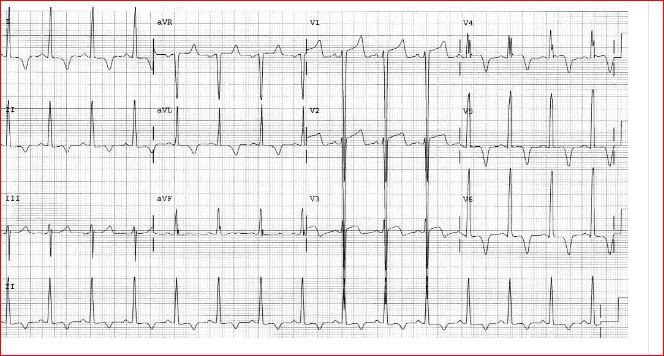An 82 y.o. woman was found unresponsive in a car. There was no evidence of trauma.
Her EKG is shown below
what is the differential based on her EKG?
Our patient had hyperkalemia with a K of 9.3. Oddly enough, this was most likely secondary to eating a whole watermelon before she collapsed.
The mortality rate for untreated severe hyperkalemia is 30%. In the field our patient was treated with an external pacemaker for a heart rate of 20. In the ED the patient was treated with atropine., Ca, insulin glucose, and albuterol . Her external pacemaker was continued with fentanyl for sedation. A junctional rhythm developed and she was dialyzed. Throughout, her trops were negative, her creatinine clearance was 37 and her K normalized. She regained her normal mental status. The differential for her initial EKG contains several possibilities.
CAUSES OF ST ELEVATION IN THE PRECORDIAL LEADS
1. Hyperkalemia- in addition to bradycardia, sine waves and peaked T waves, heart block and both st elevation and ST depression can occur
2. LBBB-often there is ST elevation in V 1,2,3
3. LVH-it is very difficult to diagnose an acute MI in the presence of LVH because there is often ST elevation in the precordial leads.
LVH with ST elevation in the precordial leads; not an MI
1. Early repolization- usually the ST segment is concave up (to hold water)
2. Ischemia- ekg changes are accompanied by pain except in the case of Wellen’s where LAD occlusion can be present even if there is no chest pain.
3. Brugada-this pattern can be seen in hyperkalemia
4. Ventricular aneursym- ST elevation can persist for years after an MI.
5. Pericarditis- ST segment elevation is in nearly all leads
Hyperkalemia often develops in patients with reduced distal sodium delivery from volume depletion, renal failure or hypotension. When exposed to high external potassium increased aldosterone activity leads to a proportional rise in K excretion and aldosterone also boosts the activity of Na/K ATPase pumps.
The use of common use of medications, including aldosterone antagonists, angiotensin-converting enzyme inhibitors, and angiotensin receptor blockers can contribute to hyperkalemia.
In addition to the patients with kidney disease, volume depletion and aldosterone antagonists; dietary sources of K must be considered.
Watermelon is an under-recognized source of excess dietary potassium, with 2 wedges (1/8th of a watermelon) containing 16.4 mmol (640 mg) of potassium. This case emphasizes the importance of dietary counseling in patients with kidney disease, including end-stage renal disease.
Why blame the watermelon?
She had been told she had mild kidney disease and diabetes, but had no signs of volume overload, no previous history of hyperkalemia and maintained her low K level after dialysis. This made a type IV RTA from her diabetes less likely as a source of her hyperkalemia. She was not on aldosterone antagonists. These facts make dietary intake a likely contributor to her hyperkalemia.
She maintained a normal K level after dialysis, her EKG normalized and has been counseled to avoid K containing foods.
Prabhu S, Saha A, Martin S. Watermelon-induced hyperkalemia: a case series. Annals of Internal Medicine volume 3 (4) https://doi.org/107326/aimcc2023.1084
12 lead workbook for the medical practitioner. Venon Stanley. www.ECGcourse.com
Greffie E, Alhalaseh S. Zaremski L. Not all ST elevation is STEMI: Brugada Pheocopy induced by hyperkalemia. Cureus 15(3): ee6951.doi:10.7759/cureus.36951m
Chan K, Yap D, Wing Li C, et al. Excessive watermelon consumption causing hyperkalaemia and increased symptom burden of an end stage renal disease patient. Case Reports Nephrology(Carlton).2016 Aug;21(8):721.doi 10.1111/nep.12655.
Te dorsthort R, Hendrikse J, Vervoorn M, et al. Review of case reports on hyperkalemia induced by dietary intake: not restricted to chronic kidney disease patients. Eur J Clin Nutr. 2019 Jan:73(1):38-45.


